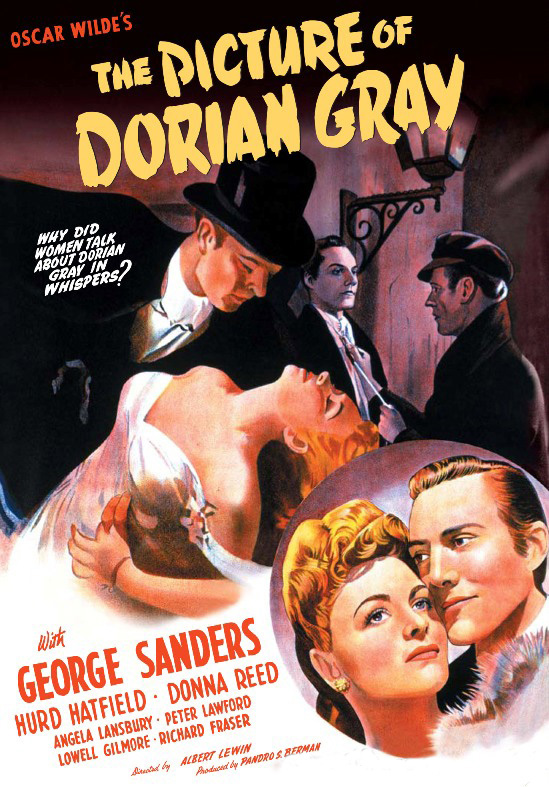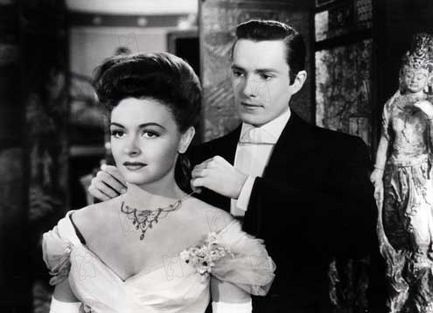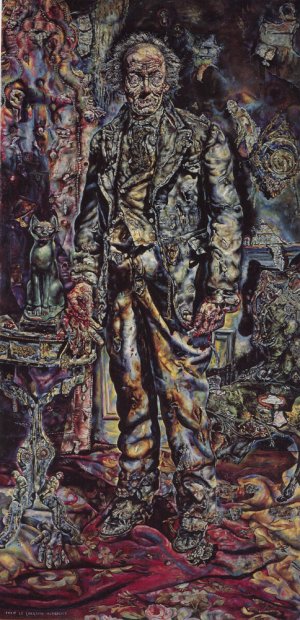The Picture Of Dorian Gray (1945)
Directed by: Albert Lewin
Written by: Albert Lewin
Starring: Angela Lansbury, Donna Reed, George Sanders, Hurd Hatfield
HCF may be one of the newest voices on the web for all things Horror and Cult, and while our aim is to bring you our best opinion of all the new and strange that hits the market, we still cannot forget about our old loves, the films that made us want to create the website to spread the word. So, now and again our official critics at the HCF headquarters have an urge to throw aside their new required copies of the week and dust down their old collection and bring them to the fore…. our aim, to make sure that you may have not missed the films that should be stood proud in your collection.
HCF REWIND NO.93. THE PICTURE OF DORIAN GRAY [1945]
AVAILABLE ON DVD
RUNNING TIME: 115 mins
REVIEWED BY: Dr Lenera, Official HCF Critic
Victorian London, 1886. Dorian Gray is a handsome, wealthy young man. While posing for a painting by his friend Basil, Dorian meets Basil’s friend Lord Henry Wotton, who tells Dorian that the only life worth living is one dedicated entirely to pleasure. After Wotton convinces Dorian that youth and beauty will bring him everything he desires, Dorian openly wishes that his portrait could age instead of him. He makes this statement in the presence of a certain Egyptian statue, which supposedly has the power to grant wishes. Dorian visits a tavern and falls in love with a singer named Sibyl Vane. Henry convinces Dorian to test her chastity and if she fails, to break off their engagement. The result: Sybil kills herself. Dorian notices a change in the portrait Basil had painted, which now hangs in his living room, and has it locked away, while he decides to dedicate himself to living a sinful and heartless life……
The Picture Of Dorian Gray remains the best version of Oscar Wilde’s The Portrait Of Dorian Gray, his great Gothic tale of morality, vanity, corruption and hypocrisy. I’ve always found it surprising that a book whose language is one of its central features has had so many film adaptations, especially when Victorian ideas about things like sin are quite different from our own, but then it is, reduced to its most basic level, a combination of Faust and a very intellectual version of Dr Jekyll And Mr Hyde, so maybe it isn’t that surprising at all. Probably the best known of the other versions is the 2009 Dorian Gray, which was a good effort but changed too much of the book for my liking. Where many of these other adaptations stumble is in taking great pains to show the terrible debauchery that Dorian is supposed to indulge in. The book merely hinted, as did the 1945 film, and if you have an imagination, that’s all you need [and even if you don’t, you surely don’t need to see the laughable montages that took up some of the 2009 version]. In fact, the imagination can often conjure up far more extreme things than any writer or filmmaker can show. The Picture Of Dorian Gray is a very subtle, understated and civilised horror film, and there are some who will say that those three words are the antithesis of horror, but a horror film it certainly is, and a particularly disturbing and thought provoking one.
I remain surprised that MGM seemed to give the very intellectual writer/director Albert Lewin carte blanche to make the film however he liked. He wrote a script which was far more faithful to the novel than one would have a right to expect, while adding in other elements of his own interest such as poetry by Omar Khayyam, which seems to have been an obsession by the director and informed his 1954 masterpiece Pandora And The Flying Dutchman. He also turned Dorian from an intense, emotional character to an icy distant one and Lord Henry into a virtual Oscar Wilde. Supposedly Greta Garbo asked to play Dorian in drag! Basil Rathbone campaigned for this part but it was thought he was too typecast as Sherlock Holmes. Donna Reed was promised the role of Sybil, Dorian’s ill-fated first love, but it was given to Angela Lansbury as she was an established singer even though she hadn’t made any films yet. Reed was given the role of Gladys, who appears later on. Stars Hurd Hatfield and George Sanders were driven mad by Lewin’s multiple takes [one scene took 130 takes], while Hatfield got very frustrated because Lewin refused to let him show expression. He also refused to photograph him after 4pm so he would never look tired. Unsurprisingly the film went hugely over budget but amazingly was a big hit.
The first thing that will probably strike first-time viewers is how talky the film is, especially with George Sanders spewing out lots of droll observations on life and insults which came from the pen of Wilde himself. Sanders is absolutely perfect for this; he delivers the lines with glorious relish and helps make Lord Henry as detestable a character as Dorian. In fact, he might be even worse, considering it is he who sends the easily influenced Dorian on his wicked path. I’ve read that he is actually a more interesting character than Dorian; I disagree. Hurd Hatfield was told by the director to keep his face immobile and show no emotion, and I think he is incredibly creepy as a result. He almost seems to be wearing a mask, but isn’t that somehow appropriate? When, later on, he begins to commit those immoral acts that the film can only allude to, the actor somehow manages to give the impression of corruption while not really doing anything at all. And even in the first third of the film when he romances Sybil, we sense he is a potentially evil creature, enhanced by her singing as cute a song as you could imagine. Does he really love her? It doesn’t really matter. He is persuaded into giving her a really cruel ‘chastity test’ [a request for someone to not go home is as obvious a film of the time could be in showing a request for sex] after which he calmly goes to the opera and she kills herself. Dorian is now on his downward path and nothing can stop him.
As its characters move dreamily through its sets beautifully shot by Harry Stradling’s deep-focus photography, The Picture Of Dorian Gray moves leisurely and rarely bothers to deliver much ‘action’ or physical horror, but it develops considerable power all the same, and this is in spite of rather intrusive narration from Cedric Hardwick, who confusingly sounds like George Sanders. He sometimes hints at Dorian’s crimes, but it’s pointless because there are enough subtle hints elsewhere. Another aspect which doesn’t work too well is the hint that a statue of an Egyptian cat may be responsible for Dorian’s Faustian pact; the book didn’t need this and neither does the film, but it was probably felt it might make audiences find it easier to accept, and in any case countless shots of the film are filled with props symbolising the themes of the story. Successive viewings really show that the amount of care taken with this film is considerable. This time I noticed a man with a board with an eye on it following Dorian into a pub. I just wish it had a bit more life to it, though it is certainly not devoid of directorial stylistics including the use of a swinging lamp during two crucial scenes that Alfred Hitchcock may well have noticed. I must admit I found the picture rather dull on my first viewing, and more than many other films, it really requires several viewings to appreciate it, but it most certainly does improve.
Many will definitely have fun at picking up the allusions to what Dorian actually gets up to, and that’s ignoring the allusions to homosexuality near the beginning [I wonder if it was the film’s high class pretensions that caused it to escape the censor’s scissors?]. Aside from murder and [unwittingly] causing a suicide, we have Dorian blackmailing a man over some previous occurrence which caused him to become a wreck. Another male friend has killed himself over something similar. A woman leaves a terrible confession after she dies. Another woman hides her face in shame when he turns up at a party. Dorian likes to go to a seedy bar [which is superbly designed in a Gothic manner] and on one occasion is shown upstairs by a dwarf [cult figure Angelo Rossitto]. Of course many modern viewers will wonder what is so bad about much of what he does, but Wilde did say: “the sins of Dorian Gray are the sins you bring to him”. He is clearly a destructive influence on everyone he meets, though one could easily ask the question what is worse; a man who persuades others to debauch themselves…or a society that continues to permit him to do so because of his money/breeding?
The one thing the film certainly isn’t subtle about is Dorian’s painting [which represents, of course, his conscience], twice shown in colour, which in its later stages is an absolute masterpiece of decadence, brilliantly showing the ravages of not so much time but evil. It took Ivan Le Lorraine Albright a year to complete it. The Picture Of Dorian Gray makes its anti-hero slightly more human than in the book towards the end, perhaps the one time the filmmakers felt constrained by the Production Code, but I feel it adds to the tragedy of the piece. With a very clever and almost underused [at least for the time] score by Herbert Strothart whose main theme will remind Disney fans of One Song from Snow White And The Seven Dwarves, this is not the most exciting film by any stretch, and may appeal more to older than younger folk, but will still probably make you think about important issues regarding our lives and the way we live them all the same. Even if you are unimpressed by it the first time, you may find yourself drawn back. I did, and I can safely now that I now love The Picture Of Dorian Gray, which remains as well as many other things a classic of psychological, personal horror, which is often the most chilling and disturbing kind there is.
Rating: 














Be the first to comment